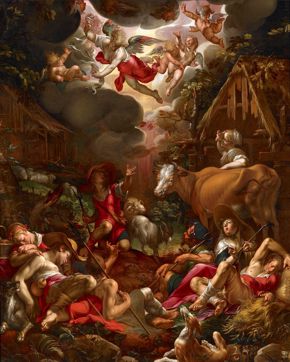A Holiday Look at “The Annunciation to the Shepherds” December 18, 2014

Joachim Wtewael, The Annunciation to the Shepherds, 1606, oil on canvas, Sarah Campbell Blaffer Foundation, Houston.
Also on view in the Beck galleries is this painting by Benjamin-Gerritsz. Cuyp (1612–1652). His depiction of the Annunciation story is just as dramatic as Joachim Wtewael's, but it is very different in color and composition.
Benjamin-Gerritsz. Cuyp, Annunciation to the Shepherds, after 1633, oil on panel, Sarah Campbell Blaffer Foundation, Houston.
In that region there were shepherds living in the fields, keeping watch over their flock by night. Then an angel of the Lord stood before them, and the glory of the Lord shone around them, and they were terrified. But the angel said to them, “Do not be afraid; for see—I am bringing you good news of great joy for all the people: to you is born this day in the city of David a Savior, who is the Messiah, the Lord.” (Luke 2:8–11, New Revised Standard Version of the Bible)
The Annunciation to the Shepherds, the colorful painting by Dutch Calvinist Joachim Wtewael (1566–1638) in the collection of the Sarah Campbell Blaffer Foundation, is one of the largest representations of the subject. The dramatic work—nearly six feet high and more than four feet wide—was painted in 1606, and it is on view in the Blaffer galleries of the Audrey Jones Beck Building.
The Netherlands of Wtewael’s time had been torn by religious strife. Shepherds were seen as models of humility for the faithful and as symbols of peace, which was said to be born of humility. French theologian John Calvin reminded his readers that life on earth is continual warfare, and Calvin interpreted the peace promised by the angels as a purely inner tranquility resulting from reconciliation with God.
Wtewael may have understood the story of the Annunciation to the Shepherds in the same way, yet in keeping with the Dutch penchant for interpreting contemporary events and scripture together, he and his viewers may also have looked to Christ, the Prince of Peace, to reconcile the Christians of the Netherlands—Protestants and Catholics alike—in a joint faith and perpetual peace.
Wtewael’s The Annunciation to the Shepherds will be featured in the exhibition Pleasure and Piety: The Art of Joachim Wtewael, opening in November 2015.





